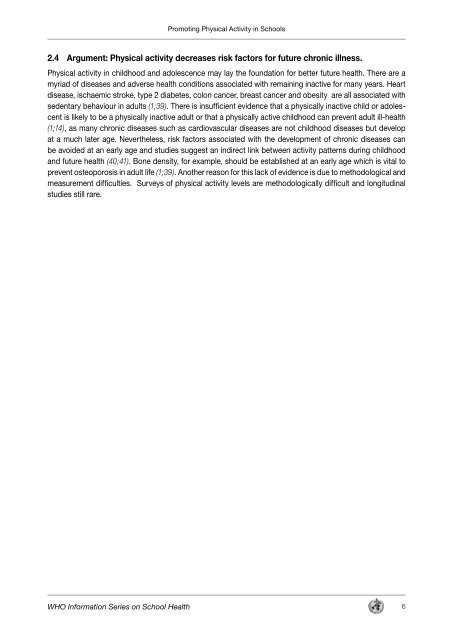WHO INFORMATION SERIES ON SCHOOL HEALTH ... - PAHO/WHO
WHO INFORMATION SERIES ON SCHOOL HEALTH ... - PAHO/WHO
WHO INFORMATION SERIES ON SCHOOL HEALTH ... - PAHO/WHO
Create successful ePaper yourself
Turn your PDF publications into a flip-book with our unique Google optimized e-Paper software.
Promoting Physical Activity in Schools<br />
2.4 Argument: Physical activity decreases risk factors for future chronic illness.<br />
Physical activity in childhood and adolescence may lay the foundation for better future health. There are a<br />
myriad of diseases and adverse health conditions associated with remaining inactive for many years. Heart<br />
disease, ischaemic stroke, type 2 diabetes, colon cancer, breast cancer and obesity are all associated with<br />
sedentary behaviour in adults (1;39). There is insufficient evidence that a physically inactive child or adolescent<br />
is likely to be a physically inactive adult or that a physically active childhood can prevent adult ill-health<br />
(1;14), as many chronic diseases such as cardiovascular diseases are not childhood diseases but develop<br />
at a much later age. Nevertheless, risk factors associated with the development of chronic diseases can<br />
be avoided at an early age and studies suggest an indirect link between activity patterns during childhood<br />
and future health (40;41). Bone density, for example, should be established at an early age which is vital to<br />
prevent osteoporosis in adult life (1;39). Another reason for this lack of evidence is due to methodological and<br />
measurement difficulties. Surveys of physical activity levels are methodologically difficult and longitudinal<br />
studies still rare.<br />
<strong>WHO</strong> Information Series on School Health 6

















